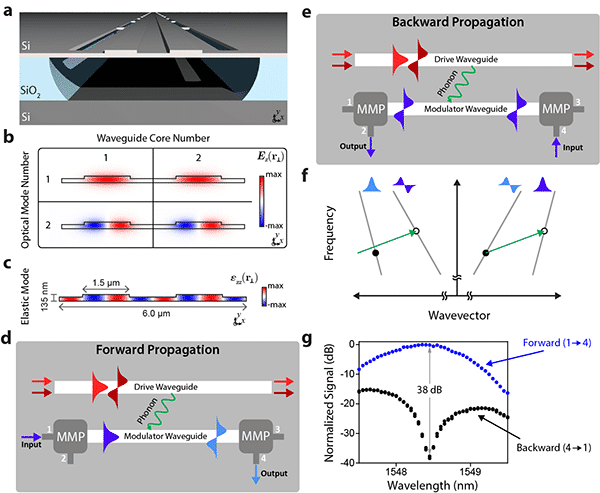
Nonreciprocal Optics with Inter-band Brillouin Scattering
Abstract: Harnessing inter-modal Brillouin couplings, we experimentally demonstrate broadband (>1 nm) nonreciprocal light propagation in an low-loss optomechanical silicon waveguide. Such traveling-wave acousto-optic interactions may enable robust and reconfigurable nonmagnetic isolators and circulators within integrated photonics.
The development of high-performance integrated photonic circuits has led to a pressing need for chip-based isolators and circulators. However, existing magneto-optic approaches to optical nonreciprocity are difficult to implement within integrated systems. Alternately, nonreciprocity may be achieved through spatiotemporal refractive index modulation used to drive unidirectional inter-band photonic transitions [1-4].
We report nonreciprocal single-sideband modulation and mode conversion through a nonlocal inter-band Brillouin scattering process [5] within a dual-core optomechanical silicon waveguide (Fig. 1a). This structure guides symmetric and anti-symmetric TE-like optical modes in each of two ridge waveguide cores (Fig. 1b). Through operation, an extended elastic wave (Fig. 1c) is excited throughout the structure by two strong optical waves guided in distinct modes of the first `drive` waveguide via stimulated inter-modal Brillouin scattering [6]. Probe light is coupled in and out of the second `modulator` waveguide using integrated mode multiplexers (MMP) as shown in Fig. 1d-e. In the forward propagation direciton, probe light is mode-converted and frequency-shifted by the incident elastic wave at frequency Ω/2π = 5.7 GHz through linear acousto-optic scattering (Fig. 1d); in the backward direction, light passes through the device unaffected (Fig. 1e). This behavior is understood through the dispersion diagram in Fig. 1f; in forward propagation (right), the phonon (green) maps light between points on the dispersion curves of the optical modes. However, this process is not phase-matched for backward propagation (left).
Through the use of a traveling-wave interaction within a 2.4-cm-long device, this process enables significant nonreciprocal contrast with a 3-dB bandwidth of >1 nm (Fig. 1g). The total excess insertion loss of this waveguide is <1 dB, demonstrating the potential for broadband, low-loss isolators and circulators in integrated photonics.

Figure 1: Nonreciprocal Brillouin modulator. (a) Artistic representation of the suspended dual-core optomechanical waveguide. (b) x-component of the electric field profiles of the four guided optical modes. (c) xx-strain distribution of the Brillouin-active elastic mode. (d-e) This elastic wave is driven through stimulated inter-modal Brillouin scattering in one waveguide. This elastic wave spatiotemporally modulates the indices of the optical modes to produce nonreciprocal mode conversion and frequency-shifting in the second waveguide core. (f) Dispersion diagram for the inter-band transition, which is phase-matched only in the forward propagation direction. (g) Experimental transmission data showing a broadband nonreciprocal response.

Powered by Eventact EMS